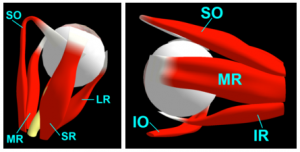The visual system is extraordinary. The eyes are the organ of vision to provide sensory information of the external world and the surrounding environment. A human eye includes a globe and 6 extraocular muscles as shown in figure 1. Eye movements are produced by the contraction or relaxation of the extraocular muscles. The extraocular muscles surround the eye to produce rotation. The muscles are arranged in 3 antagonistic pairs. The medial and lateral rectus muscles act as an antagonistic pair to control the horizontal position of the eye. Contraction of the lateral rectus and relaxation of the medial rectus causes an eye to rotate outwards and shift the gaze to sideward. The superior and inferior recti muscles control rotation upwards and downwards. The superior and inferior oblique muscles control rotation of the eye about the line of sight. This is referred to as torsional eye movement [2].

Figure 1. The six extraocular muscles are: LR-lateral rectus, MR-medial rectus, SR-superior rectus, IR-inferior rectus, SO-superior oblique, IO-inferior oblique [2].
The eyes move most commonly as involuntary responses to nearby stimuli [1]. Movements can be described as saccades, smooth pursuit, vergence, or vestibulo-ocular. Saccadic movements are most commonly involuntary movements of the eyes but can be elicited voluntarily. Saccades are extremely fast movements as both eyes simultaneously direct focus on the same position. Smooth pursuit are much slower movements of the eye. The eyes follow and track a moving object during smooth pursuit by positioning the fovea on the target. The eyes move in opposite directions and converge or diverge to observe objects at various distances during vergence eye movements. Vestibulo-ocular movements are reflex movements that are equal in magnitude but opposite in direction as head movement.
References
[1] X. Wang, Y. Zhang, X. Fu, and G. Xiang, “Design and Kinematic Analysis of a Novel Humanoid Robot Eye Using Pneumatic Artificial Muscles,” J. Bionic Eng., vol. 5, no. 3, pp. 264–270, 2008.
[2] Wei, Q., Sueda, S., & Pai, D. K. (2010). Biomechanical Simulation of Human Eye Movement. Biomedical Simulation Lecture Notes in Computer Science, 108-118. doi:10.1007/978-3-642-11615-5_12